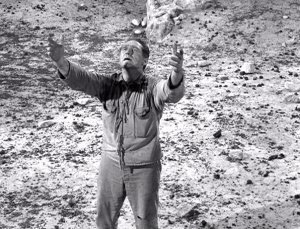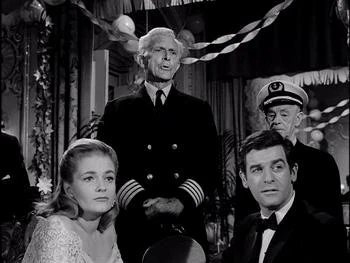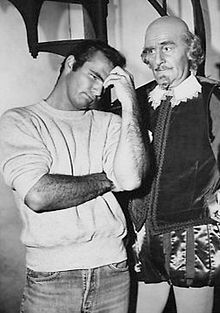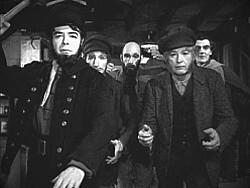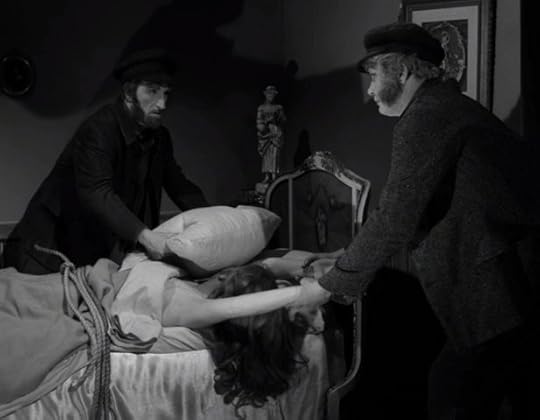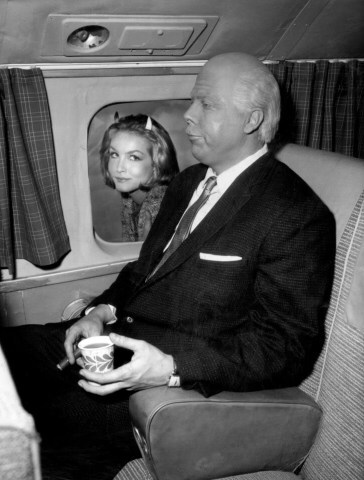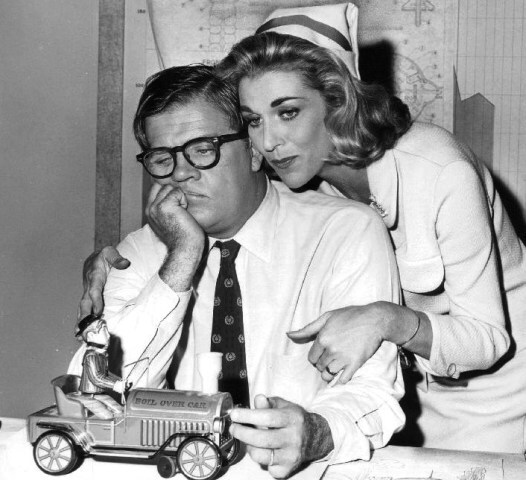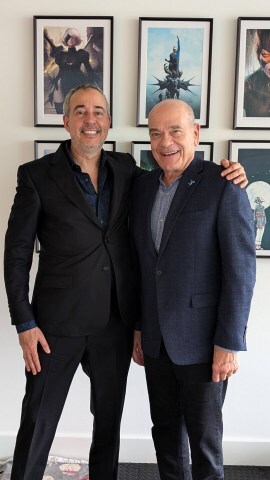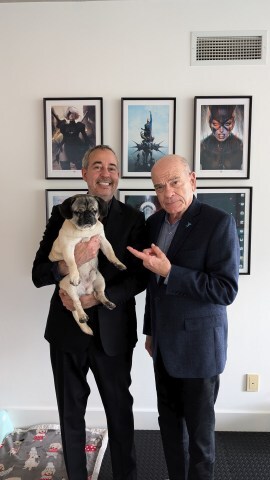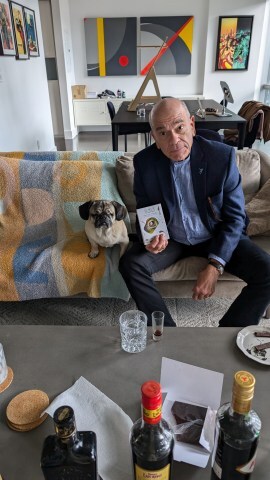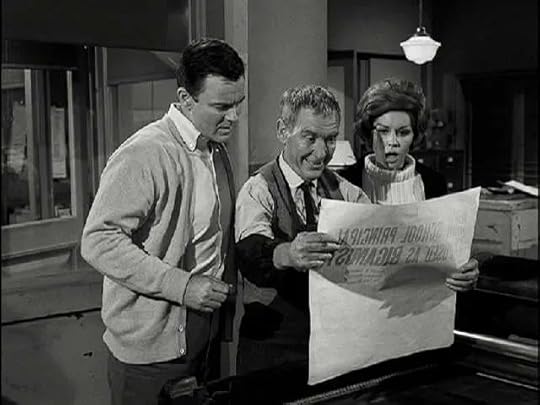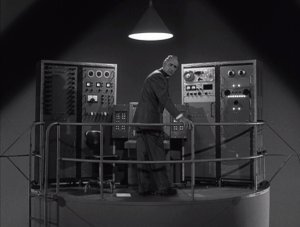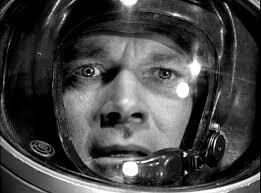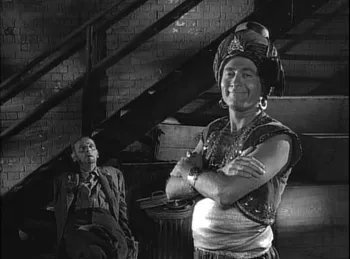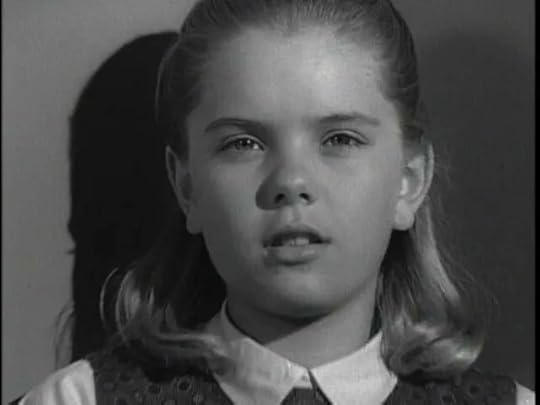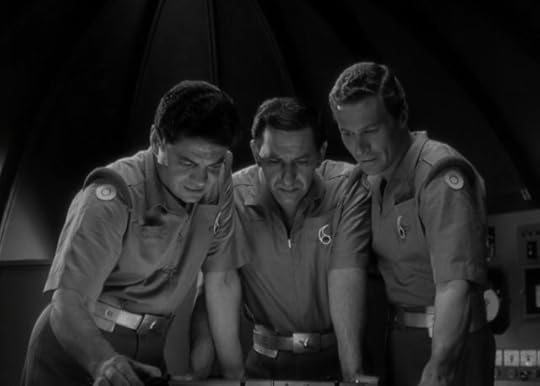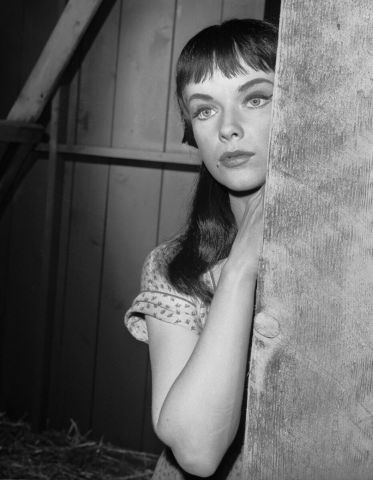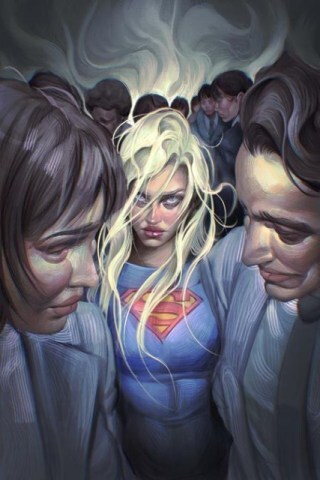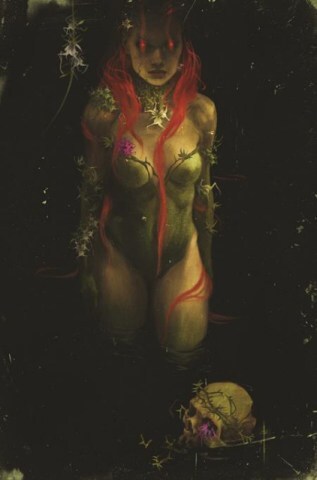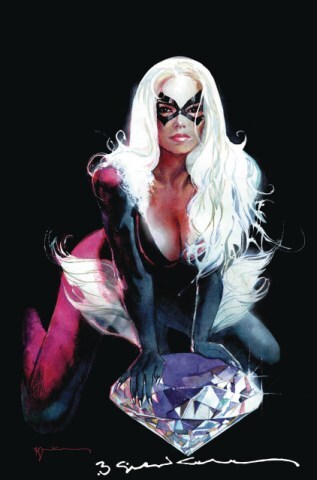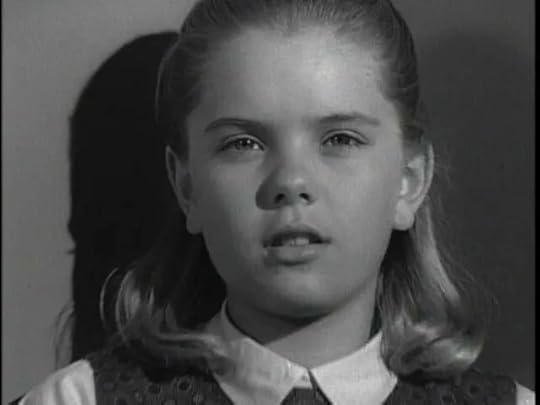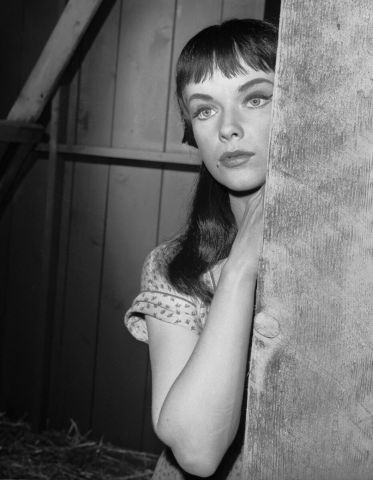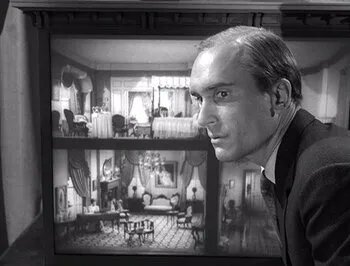Joseph Mallozzi's Blog, page 40
October 7, 2024
October 7, 2024: The Twilight Zone rewatch continues with season 4, episodes 16-18!
Season 4, Episode 16, “On Thursday We Leave for Home”
This episode first aired May 2, 1963.
The planet backgrounds, the rescue ship, and the uniforms of the rescue crew were all re-uses from Forbidden Planet (1956).
The cave where the colonists gather and seek refuge from the meteor storm was originally the underground lair of the Morlocks in The Time Machine (1960).
The ship’s interior sound effects would be re-used for the bridge of the Enterprise on Star Trek (1966).
Colonel Sloane tells the colonists that the Los Angeles Dodgers came in tenth in the 2020 season. In fact, that was the year Dodgers won the World Series, beating the Tampa Bay Rays four games to two.
In the final shot, the camera pulls back for a wide-angle crane shot of Benteen. But the night before, director Buzz Kulik was alerted to the fact that the colony shacks had no roofs (so that the interiors could be lit for filming). They ended up taping canvas roofs to the shacks overnight to make the shot work.
In an interview with Starlog Magazine, actor Tim O’Connor, who played Captain Sloane, reflected back on the set: “They constructed the entire set for that episode. There was no possible way the camera could have moved without pacing up the landscape they designed. The set was enormous! MGM studios was like a production factory back then. They saved every costume, every prop and the mountain set they built stood there for years so it could be reused. Some executive must have choked when they saw the budget. I am not surprised they didn’t tear the set down after we finished that episode.”
Rod Serling was quite proud of this episode. He told a reporter: “It’s my real conviction that this is an above-average item with consistently fine performances in which Mr. Whitmore is unique. I think it is probably one of the best Twilight Zones that we’ve ever done.”
James Broderick, who played Al Baines, was the father of actor Matthew Broderick.
The young Jo-Jo is played by director Buzz Kulik’s son Danny Kulik.
I thought this a pretty good episode that would have benefited from a more nuanced touch with Benteen’s character. He is so angry and deranged that, by episode’s end, it almost feel like he got his just desserts. But this was a guy who kept hope alive for these colonists in their darkest of days, ensuring their survival long enough for the rescue ship to arrive. In retrospect, you feel sorry for the guy but, in the moment, he comes across as stubborn and self-serving. Whitmore delivers a world-class performance but I can’t help but feel if they’d toned down the anger, made him more sad and confused than hostile, this episode would have landed much more strongly for me. Still, as it stands, a very good episode.
Season 4, Episode 17, “Passage on the Lady Anne”
This episode first aired May 9, 1963.
“Passage on the Lady Anne” is considered by some to be the final script Charles Beaumont wrote for the show before the progression of Alzheimer’s made it impossible for him to fulfill his contractual obligations to the production, necessitating his friends and fellow writers to step up and ghost write on his behalf. Not sure how true this is as writer Jerry Sohl wrote “The New Exhibit” on behalf of Beaumont four episodes earlier.
Most of the sets featured in this episode were re-uses from the film Marie Antoinette (1938) while the wardrobe was borrowed from the MGM costume department.
Director Lamont Johnson commented on the cast of veterans: “It was a joy to reunite with these great old characters and character actors. That was the chief attraction to do it. I loved hearing their anecdotes. Wilfrid Hyde-White and Gladys Cooper would sit around and gossip maliciously with enormous relish about people alive and dead, and some particularly scandalous thing that was happening currently in England or in the British colonies would send them into an absolute flashes of youth. Their eyes would glow…they would just come alive with gossip.”
Joyce Van Patten, who played Eileen Ransome, also reflected fondly on working with the pedigreed cast: “ – the greatest gift was that amazing group of great character actors they had put together. Gladys Cooper was so real and funny and she and Wilfrid Hyde-White were full of fun and tons of gossip. I could not wait to get to work and see those dynamos, the energy, the wit. It was amazing! They had it in for Cecil Kellaway and talked behind his back giggling like school kids.”
This one would have been a really good half hour episode of The Twilight Zone, but at one hour it’s just way too talky. I also felt they did away with all of the stakes partway through the episode when the Ransomes are informed they “won’t have to die” like everyone else. You know where this story is headed and letting the Ransomes off the hook well in advance of the conclusion makes for an underwhelming climax. Just so-so for me.
Season 4, Episode 18, “The Bard”
This episode first aired May 23, 1963.
This one went through many, many rewrites at the request of producer Herbert Hirschman who found the script “too comical and whimsical” for The Twilight Zone. After what seemed like countless revisions, Rod Serling finally put his foot down and wrote Hirschmann: “When we first launched this together, I too dyou that I would certainly not want you in the capacity of a rubber stamp to support my opinions constantly. You’re too fine a talent and too sensitive a man to have latched onto that kind of position which would be untenable to you. But I also said that ere would be moments when I would have to getup on my hind legs and say “No more” and I’m afraid the is is the situation with The Bard. This one I’m afraid I must ask you to swallow wholesale and then spit it out – but swallow it, you guys must. Please forgive my perfunctory hard-notedness about this one- but I can’t rewrite it anymore. Not a scene, not a line.” But Serling ended up having to do four more revisions before the episode went to camera.
Composer Fred Steiner: “My favorite comedy episode was The Bard, where I was able to write some really funny music for Jack Weston. Every show was different and you were able to use your imagination and pick a special orchestra for whatever the show required. For The Bard, I think I had a tuba, reflecting a big fat guy – Jack Weston. And for the appearance of Shakespeare, we had a a harpsichord. I did some research and found music from the old Elizabeth collection. That was a lot of fun.” The music was the element I disliked most about this episode, too broad and over-the-top.
Jack Weston (Julius Moomer) and Marge Redmond (Mr. Hugo’s secretary) were actually married at the time they appeared in this episode.
Actress Judy Strangis, who I thought did a terrific job as the young Cora, retired from acting after being stalked and switched to voice-over work.
A young Burt Reynolds does a great job spoofing Marlon Brando in this episode.
Although I did appreciate some of the shots Serling takes at the network and advertisers (The gag about making the millionaire show a multi-millionaire show and expanding it to an hour format really stood out), it really wasn’t enough to save this below-average outing. The “comedies” in particular suffer from the expanded runtime and this is a perfect example.
***
Well, that’s it for The Twilight Zone’s fourth season and probably it’s worst. But there were a few gems in the mix. Since the longer runtime also translated to half the usual number of episodes, I’m suggesting we do a Season 4 Top 5. Think about it! I’ll be posting my Top 5 in tomorrow’s blog entry.
The post October 7, 2024: The Twilight Zone rewatch continues with season 4, episodes 16-18! appeared first on Joseph Mallozzi's Weblog.
October 6, 2024
October 5, 2024: Sharky Sunday!
New freeze-fried duck treats!

Kangaroo Krisps!

Out and About with Sharky – Garlic Fest!

Letting us know…

The post October 5, 2024: Sharky Sunday! appeared first on Joseph Mallozzi's Weblog.
October 5, 2024
October 5, 2024: The Twilight Zone rewatch continues with season 4, episodes 13-15!
Season 4, Episode 13, “The New Exhibit”
This episode first aired April 4, 1963.
Although “The New Exhibit” is credited to Charles Beaumont, at this point in his life he was suffering the debilitating effects of Alzheimers so the episode ended up being ghost written by fellow writer Jerry Sohl after the two discussed the plot. According to Sohl, Beaumont: “was able to come up with an idea and sell it. But beyond the fact that these museum people were murderers. he had no story. And instead of plotting out the story, we really just chewed the fat. He seemed to waiver and talk about other things than the story. It was rather unsettling for me. He said “It’s up to you how you do this.” So I dd it. And it didn’t take every long.”
The stairway in the opening shot is the same one used in the opening shot of “The Masks”.
Actor Martin Balsam, who played Martin Senescu, was an accomplished actor of stage and screen who won a Tony Award for Best Actor in 1968 three years after receiving an Academy Award for Best Supporting Actor for his performance in A Thousand Clowns. Balsam was apparently the first to record the voice of HAL-9000 in 2001: A Space Odyssey (1968) but director Stanley Kubrick felt he sounded too colloquially American. Later in his career, Balsam fell in love with Italy and settled down there for his final years.
Margaret Field, who played Emma Senescu, was the mother of actress Sally Field.
Marcel Hillaire, who played the museum guide, is perhaps best known as the quirky German film director, Fritz, in Woody Allen’s Take the Money and Run (1969).
While Jack the Ripper is fairly notorious, the other figures that made up the museum’s murderous rogues gallery are not quite as well-known…
The axe-wielding Albert H. Hicks killed his “entire crew” aboard the E.A. Johnson, which was actually comprised of three men. He robbed them and abandoned ship but was eventually captured and hanged. Before his execution, he made a full confession and even admitted to the murders of some 100 prospectors in California gold-mining camps.
Burke and Hare were “reverse grave robbers”, murdering 16 people in Edinburgh, Scotland in 1828 in order to sell their bodies to medical science – which is why suffocation was their preferred M.O. since it left behind a relatively undamaged corpse. They happened upon their lucrative killing spree quite by accident after a lodger in Hare’s home died and they discovered the market for dead bodies. In the end, Hare flipped on Burke who got the nurse. Following his execution, his body was dissected and his skeleton put on display at the Anatomical Museum of Edinburgh Medical School.
Henri Landru murdered ten women and a teen age boy between 1914 and 1919, luring his victims through lonely-heats ads he placed in local newspapers. After killing his victims, he disposed of their bodies through dismemberment and burning. He was caught and executed via guillotine. His severed head supposedly resides in the Museum of Death in Hollywood.
This one was a lot creepier the first time I watched it – back when I was maybe 10. All the same, it’s a pretty effective little chiller. Balsam is terrific as are all the supporting players, and the murderers row is particularly terrifying. I did enjoy the twist of Martin joining his beloved rogues gallery at episode’s end. Another season 4 Top 5 candidate.
Season 4, Episode 14, “Of Late I Think of Cliffordville”
This episode first aired April 11, 1963.
This episode was based on the novelette “Blind Alley” by Malcolm Jameson, first published in the June 1943 issue of Unknown Worlds.
In the original story, Feathersmith dies an old man in the past, unable to adjust to a life devoid of modern conveniences. Also in the original story, and the first draft of the script, the devil is male.
Actor Albert Salmi, who played Feathersmith, appeared in two previous time travel-themed episodes, “Execution” (1960) and “A Quality of Mercy” (1961). Apparently, his character’s villainous laugh in this episode was not his own. According to John Anderson, who played Deidrich: ““Al’s character had to give this maniacal laugh every time he pulled something over on somebody. But poor Al could only muster up this terribly unconvincing, ‘Ha, ha.’ Director David Lowell Rich went bananas. He said, ‘John, what am I gonna do with Al’s laugh?’ I said, “Greez, David, I dunno. It sure ain’t working, is it?’ I suggested that he dub in somebody else’s laugh. They probably did, because you sure as hell couldn’t use what Al was giving them.”
Anderson previously appeared in season 1’s “A Passage for Trumpet” and season 2’s “The Odyssey of Flight 33”. Wright King, who played Hecate, appeared in season 2’s “Shadow Play”.
Julie Newmar, who played Miss Devlin, was only 15 when she was prima ballerina with the Los Angeles Opera. She is no doubt best known for her portrayal of Catwoman on Batman (1966). Reflecting back on her time on that show: “It was so wonderful being on Batman because you could be nasty and mean, and in the ’50s, women could never–unless you were some “B” picture actress–be mean, bad and nasty. It was so satisfying; I can’t tell you how satisfying it was.”
Overall, a solid episode. Yes, Salmi’s bald cap was distracting and his performance a tad hammy, but I quite liked the final twist that not only had the two men trade positions but, evidently, personalities as well. Having money presumably turns you into a jerk while not having money makes you a meek and affable fellow.
Season 4, Episode 15, “The Incredible World of Horace Ford”
This episode first aired April 18, 1963.
This episode was actually a remake of a live TV version starring Art Carney and Jason Robards. The original’s ending was much darker, concluding with the boy delivering the Mickey Mouse watch to Laura Ford who realizes her husband has been lost to the past. This ending so outraged viewers that the network received over a thousand letters either complaining about it or demanding an explanation for what the hell happened to Horace. Perhaps as a result, the Twilight Zone production requested a more upbeat (aka lamer) ending for the TZ version.
The blueprints of the toy robot Harold is building are actually copies of the blueprints Bob Kinoshita created for the design of Robbie the Robot in Forbidden Planet.
Actress Nan Martin, who played Laura Ford, reminisced about her Twilight Zone experience and working with Pat Hingle: “They flew me in from New York to do “Horace Ford”. I was flown in for a lot of television. We were known as the Jeanette MacDonald and Nelson Eddy of the stage and screen because we worked together so often. I met Rod when he came on the set. He was a very nice man. Kind of shy. But here I am, an actress, and I was in awe for Rod Serling.” As for Pat Hingle: “We were doing the street scene where Pat relieves his childhood with the street kids. I was off camera with everyone else and he played the part so well that I had chills on my back. I told someone next to me how I felt and they agreed with me.”
Pat Hingle, who played the part of Horace Ford, is perhaps better known for his portrayal of Commissioner Gordon in the Batman movies.
Alas, another dog of an episode that probably wouldn’t have fared so poorly had we not already seen variations of this exact theme done countless times before. Familiarity aside, my biggest beef with this episode is the character of Horace Ford who comes across as a spoiled, temperamental man baby. His boss was infinitely patient with him and his dismissal was long overdue. And his wife… Hell, I’ve had to suspend my disbelief many times watching the Twilight Zone, but buying into the fact that this miserable oaf had a wife like Laura was a bridge too far.
Today’s blog entry is dedicated to Birthday Gal Drea!
The post October 5, 2024: The Twilight Zone rewatch continues with season 4, episodes 13-15! appeared first on Joseph Mallozzi's Weblog.
October 4, 2024
October 4, 2024: Catching up with Bob!
I remember watching Star Trek: Voyager back in the day and really enjoying actor Robert Picardo’s endearing portrayal of The Doctor. So much so that when it came time to cast the role of uptight bureaucrat Robert Woolsey on SG-1, I suggested him. He was, of course, terrific and, over the course of his many Stargate appearances, went from I.O.A. pain-in-the-ass to Commander of the Atlantis expedition, winning over many, many fans in the process.
Bob and I have remained good friends over the years. During the Stargate days, I would have him and his family over for homemade ice cream while, on the rare occasions I visited L.A., would reciprocate with his world famous spinach pizza. Over the years, our get-togethers have been more infrequent as I haven’t had occasion to visit Los Angeles much while he’s had no reason to make the trip to Toronto. Until recently when he was cast in the upcoming Star Fleet Academy.
He’ll be in town for several months and so, earlier this week, we got together for what would be the first of, hopefully, many lunches. After our meal, we headed back to my place where Akemi (and Sharky) and I hosted an afternoon of amaro tasting…
La collection
Me and Bob
Shark insists on getting in on the action
Sharky gives the chocolate a pass
Sharky commandeers the couch.
Bob is an absolute class act and it’s always great catching up. I look forward to our next get-together given that he has promised to make pizza!
The post October 4, 2024: Catching up with Bob! appeared first on Joseph Mallozzi's Weblog.
October 3, 2024
October 3, 2024: The Twilight Zone rewatch continues with season 4, episodes 9-12!
Season 5, Episode 8, “Printer’s Devil”
This episode first aired February 28, 1963.
This episode was based on Charles Beaumont’s first published short story, “The Devil, You Say?”.
Imdb on the magical quick-snap flame: “”The special effect of Burgess Meredith creating a flame to light his cigar merely by snapping his fingers was accomplished by having two electric wires attached to a battery running up Meredith’s coat and concealed on his fingers. Meredith held his fingers in a can of ice water until they were numb, and then a crew member put lighter fluid on his fingers. Bringing the wires together created a spark that ignited the fluid so he could light the cigar.” If you look closely, you can see that Meredith’s fingers and part of his hand were covered with a flame retardant gel.
This was the only episode Ralph Serensky directed for the series. He was a Stark Trek veteran who directed such classics as “This Side of Paradise”, “Metamporphosis”, “Obsession”, “Return to Tomorrow, “Bread and Circuses”, “Is There in Truth No Beauty?”, and “The Tholian Web”, the last of which went uncredited.
Burgess Meredith makes his fourth and final Twilight Zone appearance in this episode.
Robert Sterling, who played Douglas Winters, teamed with his then wife, Anne Jeffreys, for the comedy series Topper (1953) which gained them fame on the small screen. He was considered for the role of Perry Mason (1957) but lost out to Raymond Burr.
It would seem that my early concerns about season 4’s lenghtier runtimes have been for naught (for the most part) as I enjoyed this episode as well. Meredith is terrific as always but I found the newspaper setting pretty antiquated and the ending somewhat contrived. Solid, but unlikely to make it into my season 4 Top 5.
Season 5, Episode 10, “No Time Like the Past”
This episode first aired March 7, 1963.
The original title of this episode was “You Must Go Home Again”. In the original story, a soldier from the far future takes a vacation to the past where he settles into a small town and becomes a local hero of sorts. Eventually, one of his fellow soldiers appears and makes a pitch for him to fulfill his duties and return to the future – but the soldier elects to stay put. In retrospect, that would have been a much more effective story.
This episode went through many rewrites and reshoots. Coincidentally (or not), it marked the departure of producer Herbert Hirschman and the arrival of his replacement, Bert Graner.
Originally, the episode opened with a political discourse between the two scientists. It was excised, and I can’t help but feel we dodged a bullet there. Not all of them, but that particular one anyway.
The small town set was previously used in “A Stop at Willoughby”.
“No Time Like the Past” is Serling at his hokiest. And sloppiest. This episode feels like two different episodes stitched together – and, it turns out, it esentially IS given that all of the early scenes of Driscoll going back in time in an attempt to change the past – to no avail – were added after producers viewed the initial rough cut.
What’s particularly galling is that, after the first three failed attempts to change history (one the result of a decision to answer the door for clean towels!) we are told that this proves history cannot be changed. Then Driscoll travels back to the idyllic past and is warned not to change the past because it could have terrible ramifications. But why? Didn’t we already establish the past could not be changed?
This episode felt like absolute nonsense. The moment when Driscoll just happens to remember the fire that struck this inconsequential schoolhouse had me rolling my eyes. Quite the student of history.
If you want to check out a much better written version of this story, see Harlan Ellison’s “City on the Edge of Forever” from the classic Star Trek series. I understand Ellison took issue with the way his original script was adapted but, all the same, it is miles beyond this low energy effort.
Season 4, Episode 11, “The Parallel”
This episode first aired March 14, 1963.
Serling’s trademark “Submitted for your approval…” is only heard in four episodes of the series including this one.
Shortly after the episode aired, the production faced yet another plagiarism lawsuit, this one from a writer who had submitted a story idea in season one titled “Carbon Copy”. The suit was settled for $6,500. In retrospect, Serling surely came to regret his first season decision to accept outside pitches.
In the original script, after spending their first night together following hubby’s return from space, Mr. and Mrs. Gaines realize something is….different. This was considered too risque at the time.
Actor Steve Forrest played the protagonist in this episode whiel his brother, Dana Andrews, played the time-traveling protagonist in the previous episode. No explanation for their different last names.
The house featured in this episode also appeared in “Mute”. and “Stopover in a Quiet Town”.
The consoles that appear in the Capcom communication center also appeared in The Outer Limits and The Man from U.N.C.L.E.
Overall, a fairly middling episode that I thought would have been better served by a shorter runtime. The mere idea of a parallel universe is not enough to sustain this one as Gaines is never in any real danger and, in the end, his situation is more of a major inconvenience than anything else. In the end, the problem is conveniently solved, minus any interesting twist.
Season 4, Episode 12, “I Dream of Genie”
This episode first aired March 21, 1963.
Writer John Furia was approached to write a Twilight Zone script by series producer Herbert Hirschman. According to Furia: “We had worked together before, but I had hesitated. I was not comfortable about approaching the idea in the science fiction format the Twilight Zone had established. I played with the idea of a man who imagines the possibilities – and the consequences – before choosing his one wish. Hirschman liked my proposal so I wrote the teleplay. What pleased me most was not seeing how the film turned out when it was telecast, but Serling quoted the introduction I wrote, almost verbatim.”
Furia would go on to staff on The Waltons, created by fellow TZ writer Earl Hammer Jr.
Actor-turned-director Robert Gist, who directed this episode, also helmed Star Trek’s “The Galileo Seven”.
Howard Morris, who played George P. Hanley, got his start on Sid Caesar’s “Your Show of Shows” but is perhaps best remembered as mountain man Ernest T. Bass from The Andy Griffith Show.
Jack Albertson, t.v.’s Man from Chico and the Man, returns for a second and final Twilight Zone guest spot following his appearance in season 3’s “The Shelter”.
Patricia Barry, who played sexy and sought-after 20-year-old birthday-secretary Ann was actually 40 when this episode was shot.
Sigh. What can I say? Another comedic misfire. Watching these episodes is doubly disappointing because not only are they underwhelming, but they took a slot that could have gone to a sci-fi or horror-themed script. “I Dream of Genie” is just more of what we’ve seen before on the show, less successfully executed over a longer runtime. And that “twist” ending really felt like the writer pulled it out of the very bottom of the idea bin.
The post October 3, 2024: The Twilight Zone rewatch continues with season 4, episodes 9-12! appeared first on Joseph Mallozzi's Weblog.
October 3, 2024: The Twilight Zone rewatch continues with season 4, episodes 5-8!
Season 4, Episode 5, “Mute”
This episode was first broadcast January 31, 1963.
Richard Matheson adapted his original short story for this episode. One of the more notable changes from the source material was swapping the gender of the young telepathic child from a boy (in the story) to a girl (in the episode). Presumably, the production felt a young girl would prove more sympathetic to viewers (and I think they made the right call here).
The main street Ilsa runs across was located on the MGM backlot in Culver City. It was called “New England Street” and was last glimpsed in “I Sing the Body Electric”. The Wheeler home was the “Philadelphia Story” house last seen in “A World of Difference”.
Actress Barbara Baxley, who played Cora Wheeler, was a Tony nominated Broadway performer who had a close friendship with fellow actress Tallulah Bankhead. She apparently loved cats and had one named Tulah. She (Barbara, not the cat) is perhaps best known for her portrayal of Sally Field’s mother in Norman Rae (1979).
Irene Daily, who played Miss Frank, enjoyed a successful career on Broadway and the London stage, but is best known as the scheming Liz Matthews on Another World (1964), a role that earned her a Daytime Emmy in 1979.
Anne Jillian, who played young Ilse, is best known for her role as Cassie Cranston on the 1980s sitcom It’s a Living (1980). She is a three-time Emmy nominee and won the Golden Globe for Best Actress for The Anne Jillian Story (1989).
Oscar Berengi Jr., who played Karl Werner, previously appeared in “The Rip Van Winkle Caper” and “Deaths-Head Revisited”.
I had mixed feelings about this one. The longer runtime didn’t really bother me and I found the story compelling enough, mostly thanks to a young Anne Jillian’s terrific performance. I felt sympathy for her – unlike any of the other characters. Her adoptive father was cold while her adoptive mother was an absolute loon. Her birth parents were, by all accounts, too busy with their research to give her the affection she needed. Also, when all is said and done, I’m not sure what message we’re supposed to take away from this episode? That conformity is good?
Season 4, Episode 6, “Death Ship”
This episode was first broadcast February 7, 1963.
The spaceship saucer was originally used in Forbidden Planet (1956) as were the ship’s external set and stairs as well as the crew uniforms.
After being disappointed with the results of some of the third season scripts he penned, Richard Matheson wrote Rod Serling to tell him how pleased he was with how “Death Ship” turned out. Serling wrote back: “I really thought it a beautiful job of writing and a marvelous job of production. The garland goes out to Old Man Matheson for doing it again. And speaking of doing it again – it appears we might go back to a half-hour form. Can we count on you?”
People have pointed out the similarities between this story and Ray Bradbury’s “Mars in Heaven” which, ironically enough, Richard Matheson ended up adapting to the small screen for the 1980 The Martian Chronicles miniseries.
Don Medford previously directed Jack Klugman in season 1’s “A Passage for Trumpet”. Also appearing in that episode was Mary Webster who played Ruth here. Ross Martin returns for his third Twilight Zone appearance.
Ross Elliott, who played Kramer, was a regular on General Hospital until he angrily quit the show. The production found another actor to play the role of Lee Baldwin, a character who lasted several decades. Reflecting back, Elliott once stated: “I’ll be honest with you. I made some wrong turns. I made some career decision and did some dumb things that cost me and sent me off-track…There were a few wrong turns, and there was a wrong turn or two that I won’t go into. If I hadn’t made them, my career would have had more lasting up-turns.”
Tammy Marihugh, who played Jeannie, left acting to become an exotic dancer in the 1970’s. She ended up marrying bodybuilder Rodney Larson who wound up physically abusing her. In 1996, she shot him in the back, pleaded guilty to involuntary manslaughter and, in 1997 was found guilty but given probation.
“Death Ship” is my favorite episode of season four so far. A great sci-fi concept that builds nicely to a terrific climax. I really loved the ambiguity we were seemingly left with. Is it time travel? Alien mind control? Or are they dead? Well, Serling’s closing narration effectively answers that question for us which I found kind of weird and a little disappointing.
Season 4, Episode 7, “Jess-Belle”
This episode was first broadcast on Valentine’s Day, February 14, 1963.
When a planned script fell through, the production reached out to Earl Hammer Jr. to find out if he had any finished scripts lying around. Hammer told them he would turn one around in record time for them – and he did, completing an act a day.
Actor James Best, who played Billy Ben Turner, previously played a similar character in another Hammer episode, season 3’s “The Last Rites of Jeff Myrtleback”. Reflecting back on his career, Best once said: “I got killed a lot and very seldom got a beautiful lady to work with until I did a Twilight Zone with Anne Francis. And then as my career progressed, I did The Dukes of Hazzard, and I was stuck with a dog and a hog.”
He recalled a harrowing moment while shooting this episode however: “They had the panther on the roof and I had to come out and light my pipe. And I see the trainer out in front of me, which the camera can’t see and he suppposedly had control of the animal. So I come out and I hear the trainer say “Don’t move.” And I thought “What the hell is he giving me directions for? He’s not the director!” Again, I hear “Don’t move.” And I thought “Holy poo-poo.” And I backed up and they said cut and I said “What’s wrong’ And he said “We don’t have the animal fastened on well enough, and he likes to jump on anybody that’s below him.” I said “Can you get a long chain and get on that anmal because I don’t want to come out on that porch again.””
Anne Francis, who played Jess-Belle, made her stage debut at age 11. She delivered memorable performances in movies Bad Day at Black Rock (1955), Blackboard Jnngle (1955), Forbidden Planet (1956), and received a Golden Globe (and Emmy nomination) for her portrayal of the titular character in Honey West (1965).
Jeanette Nolan, who played Granny Hart, appeared in over 300 television shows. In this episode, she plays a witch who gives Jess-Belle a love potion so that someone will fall hopeless in love with her. Her husband, actor John McIntire, played a demon who gave another character a love potion so that someone would fall hopelessly in love with him in season 1’s “The Chaser”.
I went in with low expectations but found the episode enjoyable enough. There were a few lingering questions. Like why, when she transformed, her clothes disappeared but not her engagement ring. Also, not sure why everyone assumed Jess-Belle was dead if there was no body. All in all, I actually felt sorry for Jess-Belle and thought she could have done much better than Billy Ben. She was absolutely smokin’!
Season 4, Episode 8, “Miniature”
This episode first aired February 21, 1963.
Due to a plagiarism suit, this episode was not aired in syndication and it wasn’t until the 1984 Twilight Zone 25th Anniversary special that it eventually re-aired. Although the show had faced similar charges in the past, this one went the distance, going to court where the suit was dimissed only to be appealed in 1967 and, once again, denied. The individual who sued the production had sent in a story idea years earlier that was rejected. In the story, an elderly night watchman at a department store befriends the mannequins which come alive for him at night. The old man’s daughter and son-in-law begin to worry about him and the watchman anxiously confides in his mannequin friends. He suffers a fatal heart attack and dies. The following day, his grieving daughter and son-in-law are shocked to witness the delivery of a new mannequin to the store, a mannequin that bears a striking resemblance to the recently deceased watchman. It’s no wonder the suit was thrown out. Twice.
When the episode was finally re-aired, the doll house sequences were colorized.
Although the episode is credited to Charles Beaumont, his Alzheimers had progressed to the point where he was no longer able to write so it is assumed one of his friends and fellow authors, William F. Nolan or Jerry Sohl, ghost wrote the scripts so that Beaumont could continue to maintain his health coverage.
Robert Duvall, who played Charley Parkes, was the first actor to play Lt. Frank Burns in M.A.S.H. (1970). Following his appearance in The Godfather (1972), a contract dispute resulted in his being replaced by George Hamilton in Godfather II. Other notable performances included his roles in The Great Santini (1979), Apocalypse Now (1979), and Tender Mercies (1983), but the role Duvall was most proud of was that of former Texas Ranger Augustus McCrae in the miniseries Lonesome Dove (1989).
Claire Grisworld, who played The Doll, was the wife of Oscar-winning director Sidney Pollack.
Pert Kelton, who played Mrs. Parkes, was the first actress to play Alice Kramden on The Honeymooners only to be recast after her husband, Ralph Bell, was blacklisted by the industry.
William Window, who played Dr. Wallman, was last seen as The Major in “Five Characters in Search of an Exit”.
Lennie Weinrib, who played Buddy Russell, was the original voice of Scrappy Doo but was replaced after a single season following a contract dispute.
John McLiam, who played The Guard, previously appeared in the episodes “The Shelter” and “The Midnight Sun”.
Barney Phillips, who played The Boss, makes yet another TZ appearance, this one close on the heels of “Death Ship”, leading me to assume his character DID finally make it off that planet after all!
Chet Stratton, who played The Guide, previously appeared as Roger in “The Mind and the Matter”.
I quite liked this one. Duvall does a great job conveying his lonely introvert’s quiet desperation. The episode is nicely paced and delivers a signature Twilight Zone ending. My favorite moment, however, is when the security guard glimpses Charley in the doll house but, rather than panic, he smiles because he realizes it’s a happy ending for him. Definitely a Top 5 contendor for me.
The post October 3, 2024: The Twilight Zone rewatch continues with season 4, episodes 5-8! appeared first on Joseph Mallozzi's Weblog.
October 2, 2024
October 2, 2024: Amazing Covers!
A few that caught my eye this week…
Absolute Power #4 – cover art by Juliet Nneka
Poison Ivy #26 – cover art by Sebastian Fiumara
Poison Ivy #26 – cover art by Jessica Liu Fong
Blade Runner: Tokyo Nexus #1 – cover art by Christian Ward
Black Cat #2 – cover art by Bill Sienkiewicz
Animal Warriors of the Kingdom #5 – cover art by Florencio Duyar III
So, which were YOUR favorites?
The post October 2, 2024: Amazing Covers! appeared first on Joseph Mallozzi's Weblog.
October 1, 2024
October 1, 2024: Updates!
Every year, I serve as a judge on for the Shore Script writing contest. This year, I was one of fourteen industry veterans who read six scripts competing in the TV Pilot category. Some solid scripts among the bunch, but there was one that really stood out for me and I look forward to seeing where it ranks when the winners are announced next Monday, October 7th. IF my top choice doesn’t take the crown, I’ll be reaching out to them personally to tell them I loved their script. Provided they’re on social media on course. Which every writer should be.
Today, I checked out my 500th(!) show for my ongoing CrimeBinge, a pretty awful nonsensical French thrilled called L’Esprit D’Hiver (The Spirit of Winter). To date, I’ve genuinely enjoyed 25% of what I’ve watched, 1 out of every 4 shows, which may seem like surprisingly few to some but is actually way more than I expected. I’m keeping running count of my recommendations over on X:
Can’t believe it’s been a little over a year since our scrappy little girl left us.
Well, mom is back in the hospital. Her back pain is still not under control (and quite severe in many instances) and the increase in meds only serves to make her groggy. Your input on treatments for similar conditions were greatly appreciated. I looked into SCS (Spinal Cord Stimulation) as it looked very promising, but it’s not as prevalent a treatment here in Canada. An epidural is an option as it apparently offers a 50-83% pain reduction and can offer relief for 1-3 months on average. The only problem is that the doctors are reluctant to sign off on it until all other options have been exhausted – but I really feel we’re already there. The wait time at a private clinic, on the other hand, is an absurd six months. Such is the state of our healthcare here in Canada.
The post October 1, 2024: Updates! appeared first on Joseph Mallozzi's Weblog.
September 30, 2024
September 30, 2024: The Twilight Zone rewatch continues with season 4, episodes 5-8!
Season 4, Episode 5, “Mute”
This episode was first broadcast January 31, 1963.
Richard Matheson adapted his original short story for this episode. One of the more notable changes from the source material was swapping the gender of the young telepathic child from a boy (in the story) to a girl (in the episode). Presumably, the production felt a young girl would prove more sympathetic to viewers (and I think they made the right call here).
The main street Ilsa runs across was located on the MGM backlot in Culver City. It was called “New England Street” and was last glimpsed in “I Sing the Body Electric”. The Wheeler home was the “Philadelphia Story” house last seen in “A World of Difference”.
Actress Barbara Baxley, who played Cora Wheeler, was a Tony nominated Broadway performer who had a close friendship with fellow actress Tallulah Bankhead. She apparently loved cats and had one named Tulah. She (Barbara, not the cat) is perhaps best known for her portrayal of Sally Field’s mother in Norman Rae (1979).
Irene Daily, who played Miss Frank, enjoyed a successful career on Broadway and the London stage, but is best known as the scheming Liz Matthews on Another World (1964), a role that earned her a Daytime Emmy in 1979.
Anne Jillian, who played young Ilse, is best known for her role as Cassie Cranston on the 1980s sitcom It’s a Living (1980). She is a three-time Emmy nominee and won the Golden Globe for Best Actress for The Anne Jillian Story (1989).
Oscar Berengi Jr., who played Karl Werner, previously appeared in “The Rip Van Winkle Caper” and “Deaths-Head Revisited”.
I had mixed feelings about this one. The longer runtime didn’t really bother me and I found the story compelling enough, mostly thanks to a young Anne Jillian’s terrific performance. I felt sympathy for her – unlike any of the other characters. Her adoptive father was cold while her adoptive mother was an absolute loon. Her birth parents were, by all accounts, too busy with their research to give her the affection she needed. Also, when all is said and done, I’m not sure what message we’re supposed to take away from this episode? That conformity is good?
Season 4, Episode 6, “Death Ship”
This episode was first broadcast February 7, 1963.
The spaceship saucer was originally used in Forbidden Planet (1956) as were the ship’s external set and stairs as well as the crew uniforms.
After being disappointed with the results of some of the third season scripts he penned, Richard Matheson wrote Rod Serling to tell him how pleased he was with how “Death Ship” turned out. Serling wrote back: “I really thought it a beautiful job of writing and a marvelous job of production. The garland goes out to Old Man Matheson for doing it again. And speaking of doing it again – it appears we might go back to a half-hour form. Can we count on you?”
People have pointed out the similarities between this story and Ray Bradbury’s “Mars in Heaven” which, ironically enough, Richard Matheson ended up adapting to the small screen for the 1980 The Martian Chronicles miniseries.
Don Medford previously directed Jack Klugman in season 1’s “A Passage for Trumpet”. Also appearing in that episode was Mary Webster who played Ruth here. Ross Martin returns for his third Twilight Zone appearance.
Ross Elliott, who played Kramer, was a regular on General Hospital until he angrily quit the show. The production found another actor to play the role of Lee Baldwin, a character who lasted several decades. Reflecting back, Elliott once stated: “I’ll be honest with you. I made some wrong turns. I made some career decision and did some dumb things that cost me and sent me off-track…There were a few wrong turns, and there was a wrong turn or two that I won’t go into. If I hadn’t made them, my career would have had more lasting up-turns.”
Tammy Marihugh, who played Jeannie, left acting to become an exotic dancer in the 1970’s. She ended up marrying bodybuilder Rodney Larson who wound up physically abusing her. In 1996, she shot him in the back, pleaded guilty to involuntary manslaughter and, in 1997 was found guilty but given probation.
“Death Ship” is my favorite episode of season four so far. A great sci-fi concept that builds nicely to a terrific climax. I really loved the ambiguity we were seemingly left with. Is it time travel? Alien mind control? Or are they dead? Well, Serling’s closing narration effectively answers that question for us which I found kind of weird and a little disapppointing.
Season 4, Episode 7, “Jess-Belle”
This episode was first broadcast on Valentine’s Day, February 14, 1963.
When a planned script fell through, the production reached out to Earl Hammer Jr. to find out if he had any finished scripts lying around. Hammer told them he would turn one around in record time for them – and he did, completing an act a day.
Actor James Best, who played Billy Ben Turner, previously played a similar character in another Hammer episode, season 3’s “The Last Rites of Jeff Myrtleback”. Reflecting back on his career, Best once said: “I got killed a lot and very seldom got a beautiful lady to work with until I did a Twilight Zone with Anne Francis. And then as my career progressed, I did The Dukes of Hazzard, and I was stuck with a dog and a hog.”
He recalled a harrowing moment while shooting this episode however: “They had the panther on the roof and I had to come out and light my pipe. And I see the trainer out in front of me, which the camera can’t see and he suppposedly had control of the animal. So I come out and I hear the trainer say “Don’t move.” And I thought “What the hell is he giving me directions for? He’s not the director!” Again, I hear “Don’t move.” And I thought “Holy poo-poo.” And I backed up and they said cut and I said “What’s wrong’ And he said “We don’t have the animal fastened on well enough, and he likes to jump on anybody that’s below him.” I said “Can you get a long chain and get on that anmal because I don’t want to come out on that porch again.””
Anne Francis, who played Jess-Belle, made her stage debut at age 11. She delivered memorable performances in movies Bad Day at Black Rock (1955), Blackboard Jnngle (1955), Forbidden Planet (1956), and received a Golden Globe (and Emmy nomination) for her portrayal of the titular character in Honey West (1965).
Jeanette Nolan, who played Granny Hart, appeared in over 300 television shows. In this episode, she plays a witch who gives Jess-Belle a love potion so that someone will fall hopeless in love with her. Her husband, actor John McIntire, played a demon who gave another character a love potion so that someone would fall hopelessly in love with him in season 1’s “The Chaser”.
I went in with low expectations but found the episode enjoyable enough. There were a few lingering questions. Like why, when she transformed, her clothes disappeared but not her engagement ring. Also, not sure why everyone assumed Jess-Belle was dead if there was no body. All in all, I actually felt sorry for Jess-Belle and thought she could have done much better than Billy Ben. She was absolutely smokin’!
Season 4, Episode 8, “Miniature”
This episode first aired February 21, 1963.
Due to a plagiarism suit, this episode was not aired in syndication and it wasn’t until the 1984 Twilight Zone 25th Anniversary special that it eventually re-aired. Although the show had faced similar charges in the past, this one went the distance, going to court where the suit was dimissed only to be appealed in 1967 and, once again, denied. The individual who sued the production had sent in a story idea years earlier that was rejected. In the story, an elderly night watchman at a department store befriends the mannequins which come alive for him at night. The old man’s daughter and son-in-law begin to worry about him and the watchman anxiously confides in his mannequin friends. He suffers a fatal heart attack and dies. The following day, his grieving daughter and son-in-law are shocked to witness the delivery of a new mannequin to the store, a mannequin that bears a striking resemblance to the recently deceased watchman. It’s no wonder the suit was thrown out. Twice.
When the episode was finally re-aired, the doll house sequences were colorized.
Although the episode is credited to Charles Beaumont, his Alzheimers had progressed to the point where he was no longer able to write so it is assumed one of his friends and fellow authors, William F. Nolan or Jerry Sohl, ghost wrote the scripts so that Beaumont could continue to maintain his health coverage.
Robert Duvall, who played Charley Parkes, was the first actor to play Lt. Frank Burns in M.A.S.H. (1970). Following his appearance in The Godfather (1972), a contract dispute resulted in his being replaced by George Hamilton in Godfather II. Other notable performances included his roles in The Great Santini (1979), Apocalypse Now (1979), and Tender Mercies (1983), but the role Duvall was most proud of was that of former Texas Ranger Augustus McCrae in the miniseries Lonesome Dove (1989).
Claire Grisworld, who played The Doll, was the wife of Oscar-winning director Sidney Pollack.
Pert Kelton, who played Mrs. Parkes, was the first actress to play Alice Kramden on The Honeymooners only to be recast after her husband, Ralph Bell, was blacklisted by the industry.
William Window, who played Dr. Wallman, was last seen as The Major in “Five Characters in Search of an Exit”.
Lennie Weinrib, who played Buddy Russell, was the original voice of Scrappy Doo but was replaced after a single season following a contract dispute.
John McLiam, who played The Guard, previously appeared in the episodes “The Shelter” and “The Midnight Sun”.
Barney Phillips, who played The Boss, makes yet another TZ appearance, this one close on the heels of “Death Ship”, leading me to assume his character DID finally make it off that planet after all!
Chet Stratton, who played The Guide, previously appeared as Roger in “The Mind and the Matter”.
I quite liked this one. Duvall does a great job conveying his lonely introvert’s quiet desperation. The episode is nicely paced and delivers a signature Twilight Zone ending. My favorite moment, however, is when the security guard glimpses Charley in the doll house but, rather than panic, he smiles because he realizes it’s a happy ending for him. Definitely a Top 5 contendor for me.
The post September 30, 2024: The Twilight Zone rewatch continues with season 4, episodes 5-8! appeared first on Joseph Mallozzi's Weblog.
September 29, 2024
September 29, 2024: Sharky Sunday!
Enjoying his banana chip…

Out and About…

Enjoying some quail meatballs…
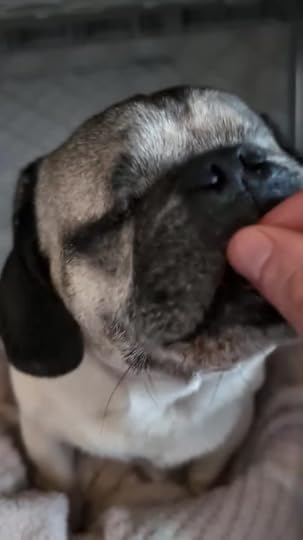
He’s been unusually itching of late…

And increasingly more vocal…

Slow-Mo Strawberry Boy…

The post September 29, 2024: Sharky Sunday! appeared first on Joseph Mallozzi's Weblog.
Joseph Mallozzi's Blog
- Joseph Mallozzi's profile
- 39 followers


